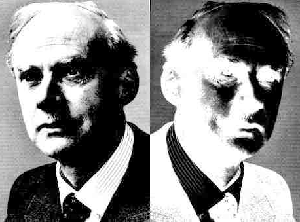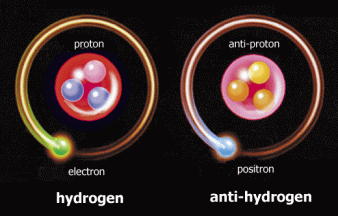Antimatter: what is it? Something exotic and not real?
 |
Fig. 1: Photograph of Dirac and its negative: Dirac-AntiDirac. |
Everything which surrounds us is made of matter. But what
is antimatter? How did this concept come about?
To answer these questions we should go back in time to the 1930s.
In 1928 the British physicist Paul Dirac formulated a
theory for the motion of
electrons![]() in the presence of electric and magnetic
fields; the theory included
quantum effects
in the presence of electric and magnetic
fields; the theory included
quantum effects![]() and also
relativistic effects
and also
relativistic effects![]() .
.
This theory explained extremely well the experimental results and it led to a surprising prediction.
The electron should have had a corresponding "antiparticle![]() " with
the same mass and opposite
electric charge
" with
the same mass and opposite
electric charge![]() .
.
Dirac's theory had experimental confirmation in 1932 with the discovery of
the positron.
 |
Fig. 2: Artistic representation of one hydrogen atom and one of anti-hydrogen. (Credit: INFN-Notizie N.13 Febrary 2003 "A caccia di antimateria: l'esperimento ATHENA" ) |
We now know that each particle with half integer spin![]() has a corresponding antiparticle. While the mass of a particle and that of the
corresponding antiparticle are exactly the same, other properties are equal but
have the opposite sign. For instance, the antiproton has the same mass as the
proton
has a corresponding antiparticle. While the mass of a particle and that of the
corresponding antiparticle are exactly the same, other properties are equal but
have the opposite sign. For instance, the antiproton has the same mass as the
proton![]() but the electric charge is opposite (the charge of the
proton is positive, that of the antiproton negative).
but the electric charge is opposite (the charge of the
proton is positive, that of the antiproton negative).
Also to electrically neutral particles, like the
neutrons![]() ,
there are corresponding antiparticles. They have equal properties, some of which with
the opposite sign (like the magnetic moment)
,
there are corresponding antiparticles. They have equal properties, some of which with
the opposite sign (like the magnetic moment)
When matter and antimatter particles collide they annihilate into energy, radiation.